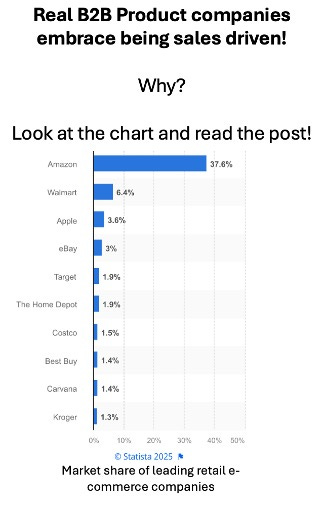Real product companies aren't "sales driven" … but guess what, that's a lie!😮
Why?🤔
In the enterprise space, a small handful of companies dominate their markets -and if you want their business, you need to do it their way!💪🏽
👉🏽In US parcel, UPS, FedEx, and the Post Office control 90%+ of the market.
👉🏽In Ecommerce, Amazon, Walmart, Apple, and eBay control over 50% of the market.
👉🏽In insurance, 10 companies control 50% of the market.
In category after category, a few companies own the lion's share of the market.
So does it mean you should chase every deal and have an entirely sales-controlled strategy? No!
Instead, you need to design your roadmap and offering in a way that it easily supports customizations in order to meet the needs of the largest customers, so when sales brings you a whale that demands X,Y, & Z, it's just par for the course.
The same logic applies to modernizations.
One of the biggest issues I see time and time again is that teams ignore the requirements of their largest customers, until almost the supposedly very end, only to discover a huge amount of work and rework that needs to be done to migrate them.
If team's realized that they need to treat their largest customers as segments of 1, because that's often what they are, they could have addressed the issues early on.
Instead they are either forced to do a ton of rework and extra work that wasn't planned for, or leave them on the legacy systems.
And this is why there are so many orphan or stranded applications!
Because the teams failed to account for these largest customers, that looked nothing like the rest of their customers, and discovered the solution they were building wouldn't meet their needs.
Which is why one of the key tenets of the Minimum Viable Replacement Framework is to:
Identify the extremes, e.g. how do your largest customers look like compared to everyone else.
Design and architect for the 1% of your use cases that drive the majority of your complexity and impact
It doesn't mean you are going to be able to serve their needs out of the gate, but at least you've taken them into account for your design and planning at the beginning , as opposed towards the "end" of the project.
After all, wouldn't it be better to know at the beginning you need to prepare for Everest versus Pikes Peak, a mountain you can drive up?
Modernizations are filled with all sorts of landmines like this, which is I developed:
The MVR Framework to give you a language and structured process to navigate the unique challenges of modernizations and develop more realistic product plans.
The Watermelon Preventer, a simple questionnaire to help you uncover key risks early in your initiatives, so you can address them before the oh-so-predictable blizzard surprises you. Why do I call it the Watermelon preventer? because the goal is to prevent your supposedly green project from turning red.
Risk Mitigation Guides, to help you identify potential risk mitigation options to address the challenges uncovered by the Watermelon Preventer.
I hope you find them helpful!
Let me know what you think! I‘d love your feedback. 🙏
Have a great week!
Kev




